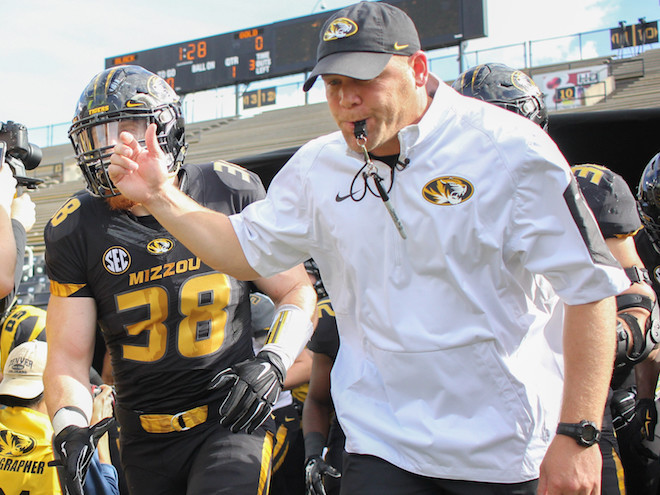NCAA rule change a boon for Missouri

On Tuesday, the NCAA voted to allow schools to pay for round-trip travel for two parents or legal guardians on recruits' official visits. Previously, schools were only allowed to pay for travel and meals for recruits themselves, leaving the parents of out-of-state recruits in a lurch.
Starting Aug. 1, 2016, however, that will change. Now, the only thing preventing parents from seeing their sons' potential schools are time demands.
On Wednesday, a Missouri team spokesperson provided a statement from head coach Barry Odom on the rule change -- one that was passed 14-1. Only the Sun Belt Conference voted against it.
"Recruiting for our staff is identifying the best fit for our program and university. We feel very strongly in developing a true relationship with those student-athletes and their families. We are excited that we will have the opportunity to assist parents in getting them on our camps. When we get prospective student-athletes and their parents on our campus, we have the opportunity to show them that the University of Missouri has the resources to win championships, provide an unmatched education and a college experience that will change their lives forever." -- Barry Odom, Missouri head coach
This rule change is a huge boon for schools like Missouri, which have to do a large part of their recruiting not just out of state, but out of region. That makes it tough to find a large chunk of their recruiting base within driving distance.
Let's take a look at Missouri's most recent recruiting classes (2015 and 2016) to see on average how far away the out-of-state recruits had to travel. For the purpose of this exercise, we're excluding junior college signees with a high school connection to Missouri, and we're grouping in the metro areas of Kansas City and St. Louis into the in-state recruit category.
| Year | No. of OOS recruits signed | Longest distance (one-way) | Shortest distance (one-way) | No. of OOS recruits within 400 mile drive | Average distance (one-way) |
|---|---|---|---|---|---|
|
2016 |
9 (out of 20 total) |
1,745.8 miles (Dominic Collins from Mission Viejo, Cali.) |
212.4 (Albert Okwuegbunam from Springfield, Ill.) |
3 (out of 9 true OOS recruits) |
802.4 miles |
|
2015 |
11 (out of 25) |
1,931 miles (Malik Cuellar from San Francisco) |
393.9 (Johnathon Johnson from Memphis, Tenn.) |
1 (out of 11 true OOS recruits) |
1,046.5 miles |
Hypothetically, in 2016, if a recruit and his parents drove the average distance (802.4 miles) at 75 miles per hour the entire way, it would be a 20-hour round trip car ride. In the 2015 class -- and again, the same scenario -- it would be a 28-hour round trip in the car.
Missouri's recruiting shifted dramatically south and east after its move to the SEC before the 2012 season. The Tigers also went more aggressively after the California junior college players, so the shift in distance is understandable. Now, Barry Odom is re-doubling Missouri's efforts in Texas -- a big state, obviously, but one that seems geographically closer to Columbia than the Deep South.
Let's take a look at the most recent recruiting class, fully signed before Missouri's conference switch. That would be the 2011 class.
| Year | No. of OOS recruits signed | Longest distance (one-way) | Shortest distance (one-way) | No. of OOS recruits within 400 mile drive | Average distance (one-way) |
|---|---|---|---|---|---|
|
2011 |
12 (out of 17) |
875.9 miles (Clarence Green from Clute, TX) |
442.4 (Kentrell Brothers from |
0 |
655 |
Going back to the hypothetical travel scenario, it's a closer drive, but it's still a nearly 19-hour round trip -- depending on food and bathroom demands.
To further drive home the point of how important this rule change is for Missouri, let's take a look at Missouri's current offer list. Again, these are self-reported offers and not official.
We're looking at in-state offers (a relative easy drive) and then bordering state recruits (Illinois, Kentucky, Tennessee, Arkansas, Oklahoma, Kansas, Iowa). That doesn't even factor in that Tennessee, Oklahoma and Kentucky share smaller borders with Missouri, so a recruit from, say, Nashville is still a 12-hour round trip (at least) by car.
Then let's compare it to Missouri's offers in Texas.
| 2017 offers (as of April 20) | Offers to in-state recruits | Offers to bordering state recruits | Offers to Texas recruits |
|---|---|---|---|
|
173 |
5 |
19 |
27 |
Missouri has more offers in Texas alone than offers to in-state and bordering-state recruits combined. It has 22 offers out to recruits from Florida, almost equal to the 'close-proximity' group.
Will Missouri start landing more of these out-of-state recruits? Maybe. Maybe not. But the key is that they'll have a pretty opportunity to paint the full picture of the program, of the university, of the town with parents and guardians now easily able to take a free trip.
After the events and media coverage of last fall, too, it couldn't have come at a better time.